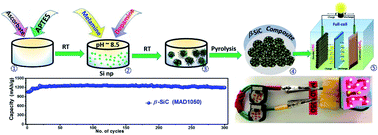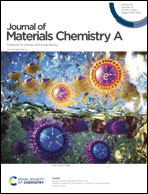Zinc blende inspired rational design of a β-SiC based resilient anode material for lithium-ion batteries†
Abstract
A zinc blende variant of silicon carbide (i.e. β-SiC), despite being rich in interstitial sites with tetrahedrally configured symmetry and having the potential to host Li+-ions swiftly, along with unusual mechanical, thermal and chemical stabilities, has not been explored for its potential in the context of LIB systems. The demanding energy consuming carbothermic synthesis process (Acheson process, 1700–2500 °C) and sluggish lithiation kinetics owing to the very high surface lithiation energy of bare SiC, impeded its adaptability and reach in the battery community. In this work, we have developed a facile, affordable and scalable methodology free from any sophisticated instrumentation to circumvent these issues. The present methodology requires a much lower temperature (as low as ∼600 °C) to crystalize β-SiC nanoparticles in a carbon matrix. Simultaneously, it further ensures the seamless integration of the embedded β-SiC nanoparticles with the host carbon matrix, a much-needed trait for effective promotion of charge and mass transfer during lithiation–delithiation. Benefiting from the deliberate structural design, the β-SiC based anode delivers high reversible capacity (∼1250 mA h g−1), exhibits high capacity retention (∼94% i.e. 1195 mA h g−1 after 300 cycles at 50 mA g−1 and 707 mA h g−1 after 525 cyles at 1000 mA g−1) and offers excellent rate capacities (1128, 1066, 984, 937, 852, 684, 532 and 1256 mA h g−1 at 50, 100, 200, 300, 500, 1000, 2000 and 50 mA g−1, respectively). Moreover, the successful integration of β-SiC based anodes in full cells (commercial LiCoO2 as the cathode) for the effective powering of portable electronic devices advocates its compatibility, practicability and potential to serve as a negative electrode in commercial LIB systems. Overall, the present methodology can be the missing link in the making of electrochemically active β-SiC based electrodes available for extensive LIB related studies and many more.



 Please wait while we load your content...
Please wait while we load your content...